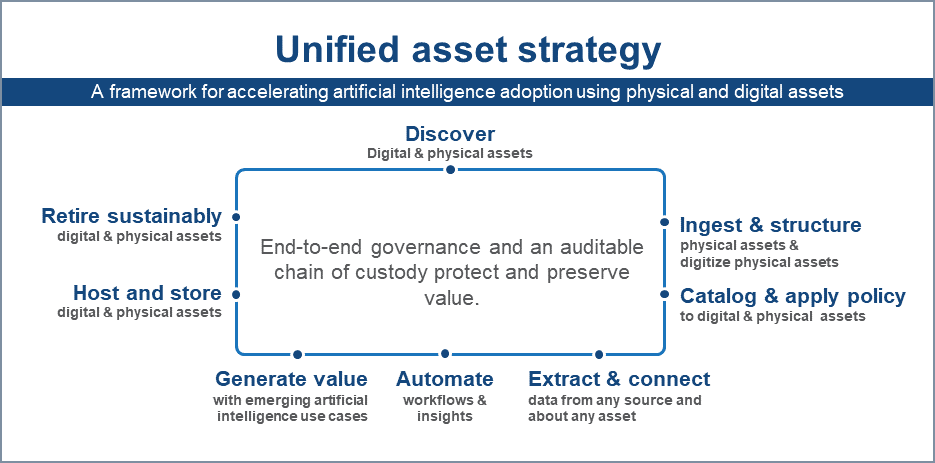Elevate the power of your work
Get a FREE consultation today!
Organizations striving to innovate using emerging artificial intelligence (AI) capabilities must strategically manage digital and physical assets while mitigating privacy, security, and scalability risks. A unified asset strategy paves the way to new AI frontiers.

What percentage of your enterprise’s assets contribute to your bottom line? What’s gathering dust, creating physical or digital clutter, and generally sliding through its useful “life” undiscovered and ungoverned could be used to explore new artificial intelligence (AI) frontiers leading to innovation. Assets are almost anything that inherently holds value: physical mail, email, and chats; paper and database records; audio and video reels; photographs; recorded media; film props; fine art and other collectibles; IT equipment; IoT devices; and whatever else might be used for AI training purposes or otherwise leveraged by evolving AI-centric use cases.
In emerging AI frontiers such as AI-driven automation, generative AI, and immersive experiences, progressive enterprises blend physical and digital realms to reshape our perception of and interaction with the world around us. Organizations venturing into these areas are discovering the value in data previously locked in analog (or physical) formats that can be used to train traditional and emerging AI models, build immersive experiences, and even protect and optimize the value of assets across their lifecycles.
Unfortunately, many enterprises are ill-prepared to leverage these types of assets due to poor visibility and control, confusion about what to keep (and for how long) and what to digitize, how to use technology to extract data and metadata from unstructured information, how to set policy to protect and manage data, and so on. They don’t know what they have, and they rarely consolidate the management of physical and digital assets. Some still use spreadsheets to track physical assets.
As we realize that every thing—every asset that is relevant, authentic, and accurate—inherently holds and is “information” that can contribute to or benefit from AI use cases, we must also realize this: We must evolve our information and data management strategies to protect, manage, and optimize assets in an increasingly complex regulatory and security environment from creation to responsible end-of-life. This is where a unified asset strategy comes into play—to help enterprises prepare for emerging AI-centric use cases that integrate and leverage digital and physical assets and protect those assets to reduce risk and maximize return.
Unlike traditional digital and physical asset management, a unified asset strategy is a holistic, systematic framework for maximizing the value of any asset.

This framework uses digital capabilities and services to discover, digitize, and extract information from analog assets and then protect, govern, connect, analyze, enrich, preserve, and responsibly dispose of or remarket digital and physical assets.
A unified asset strategy draws on three principles that enable physical and digital asset protection and value creation.
A unified asset strategy enables an organization’s disparate goals, initiatives, and requirements under one empowering umbrella. This means an enterprise can scale to handle data management, curation, and access for analytics and AI applications across multi-cloud environments. It can protect assets of any type to reduce security and privacy risk and loss. It can help enterprises innovate and adapt to disruptions.
Here are the essential capabilities of a robust unified asset strategy:
A unified asset strategy operationalizes the hidden value in physical and digital assets while safeguarding them. Through unifying management of digital and physical assets, enterprises can establish a foundation to drive innovation with AI-driven insights and actions.
For an in-depth look at the challenges and opportunities creating a sense of urgency for a unified asset strategy—through the words of enterprise leaders like you—read Boost enterprise-wide innovation with a unified asset strategy. If you’re unsure that your organization is doing enough to identify and protect your most valuable assets, contact Iron Mountain about our Information Governance Advisory Services.
Get a FREE consultation today!

